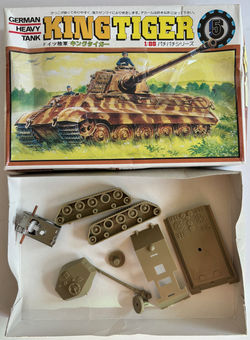KAWAI
HO-scale WW2 GERMAN PANZERKAMPFWAGEN VI KING TIGER TANK Kit NORMANDY KURSK
EASTERN FRONT RUSSIA Sd.Kfz.182 KJT-05 (c.1980)
Unbuilt plastic model kit –
ready to build and mount on a model railroad flatcar or add to a WW2 track
layout diorama
Includes clockwork motor that
also serves as a weight.
Instructions are printed on the
backside of the box cover.
--------------------------------------------------------------------
Additional
Information from Internet Encyclopedia
Tiger
II is the common name of a german heavy tank of the second world war. The final
official german designation was panzerkampfwagen tiger ausf. B, often shortened
to tiger b. The ordnance inventory designation was sd.kfz. 182. It is also
known under the informal name königstiger (the german name for the "bengal
tiger"), often semi-literally translated as the king tiger or royal tiger
by allied soldiers.
The
design followed the same concept as the tiger I, but was intended to be even
more formidable. The tiger ii combined the thick armor of the tiger I with the
sloped armor used on the panther medium tank. The tank weighed almost seventy
metric tons, was protected by 100 to 180 mm (3.9 to 7.1 in) of armor to the
front, and was armed with the long barreled 8.8 cm kampfwagenkanone 43 l/71
gun. The chassis was also the basis for the jagdtiger turretless tank
destroyer.
The
Tiger II was issued to heavy tank battalions of the army (schwere
heerespanzerabteilung - abbreviated s.h.pz.abt) and the waffen-ss
(s.ss.pz.abt). It was first used in combat with s.h.pz.abt. 503 during the
normandy campaign on 11 july 1944; on the eastern front the first unit to be
outfitted with tiger iis was the s.h.pz.abt. 501 which by 1 september 1944
listed 25 tiger iis operational.
Development
of a heavy tank design had been initiated in 1937; the initial design contract
was awarded to henschel. Another contract followed in 1939, and was given to
porsche. Both prototype series used the same turret design from krupp; the main
differences were in the hull, transmission, suspension and automotive features.
The
henschel version used a conventional hull design with sloped armor resembling
the layout of the panther tank. It had a rear mounted engine and used nine
steel-tired overlapping road wheels with internal springing per side, mounted
on transverse torsion bars, in a similar manner to the original tiger. To
simplify maintenance, however, the wheels were overlapping rather than
interleaved as in the tiger i.
The
porsche hull designs included a rear-mounted turret and a mid-mounted engine.
The suspension was the same as on the elefant tank destroyer. This had six road
wheels per side mounted in paired bogies sprung with short longitudinal torsion
bars that were integral to the wheel pair; this saved internal space and
facilitated repairs. One porsche version had a gasoline-electric drive, similar
to a gasoline-electric hybrid but without a storage battery; two separate drive
trains in parallel, one per side of the tank, each consisting of a hybrid drive
train; gasoline engine – electric generator – electric motor – drive sprocket.
This method of propulsion had been attempted before on the tiger (p) (later
elefant prototypes) and in some us designs, but had never been put into
production. The porsche suspension were later used on a few of the later
jagdtiger tank hunters.
The
turrets were designed to mount the 8.8 cm kwk 43 l/71 gun. Combined with the
turmzielfernrohr 9d (german "turret telescopic sight") monocular
sight by leitz, which all but a few early tiger iis used, it was a very
accurate and deadly weapon.
Like
all german tanks, it had a gasoline engine; in this case the same 700 ps (690
hp, 515 kw) v-12 maybach hl 230 p30 which powered the much lighter panther and
tiger i tanks. The tiger ii was under-powered, like many other heavy tanks of
world war ii, and consumed a lot of fuel, which was in short supply for the
germans. The transmission was the maybach olvar eg 40 12 16 model b, giving
eight forward gears and four reverse, which drove the steering gear. This was
the henschel l 801, a double radius design which proved susceptible to failure.
Transverse torsion bar suspension supported the hull on nine axles per side.
Overlapped 800 mm (31 in) diameter road wheels with rubber cushions and steel
tyres rode inside the tracks.
The
command variant of the tiger ii was designated panzerbefehlswagen tiger ausf.
B. It had two versions, sd.kfz. 267 and sd.kfz. 268. These carried only 63
rounds of 8.8 cm ammunition to provide room to accommodate the extra radios and
equipment, and had additional armor on the engine compartment. The sd.kfz. 267
was to have used fug 8 and fug 5 radio sets, with the most notable external
changes being a two metre long rod antenna mounted on the turret roof and a
sternantenna d ("star antenna d"), mounted on an insulated base (the
104mm antennenfuss nr. 1) which was protected by a large armored cylinder. This
equipment was located on the rear decking in a position originally used for
deep-wading equipment. The sd.kfz. 268 used fug 7 and fug 5 radios with a two
metre rod antenna mounted on the turret roof and a 1.4 metre rod antenna
mounted on the rear deck.





